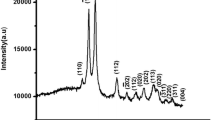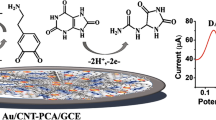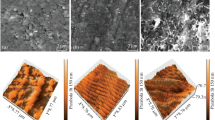Abstract
In this work, CeO2 nanocubes prepared by a simple co-precipitation method were employed for the determination of dopamine (DA) using an electrochemical method. The prepared material was characterized using morphological analysis like Transmission Electron Microscope (TEM) and the chemical structure was elucidated using X-ray diffraction (XRD), X-ray photoelectron spectroscopy (XPS), Raman and Fourier Transform Infrared (FTIR) spectroscopy respectively. From the TEM analysis, the growth of CeO2 nanocubes into nanorods was observed and particle size was determined to be 10 nm. The presence of cubic crystalline structure was confirmed through XRD and the structural analysis was confirmed using FTIR and Raman spectroscopy. The oxidation state of the elements was confirmed through XPS analysis. For the electrochemical redox reaction of DA, the CeO2-modified glassy carbon electrode (GCE) showed excellent catalytic activity towards the DA oxidation compared to bare GCE. The detection of DA using differential pulse voltammetry (DPV) showed a limit of detection (LOD) of 3.2 µM and a linear range of 10-300 µM, respectively. Similarly, for UA and AA, the detection limit and linear range were found to be 4.3 µM and 10 µM-700 µM for UA; 14 µM and 10 µM-250 µM, respectively for AA. The repeatability and reproducibility of the sensor were studied and the veracity of the sensor towards the estimation of DA in blood serum samples was analyzed. The admirable performance of the present biosensor could be potentially useful for biomedical applications.
Graphical abstract
CeO2 nanocubes were prepared by a facile chemical method. The enhanced catalytic activity was exhibited by CeO2 nanocubes towards the electro-oxidation of dopamine and excellent selectivity in the presence of uric acid and ascorbic acid.







Similar content being viewed by others
References
Ranjbar-Slamloo Y and Fazlali Z 2020 Dopamine and noradrenaline in the brain; overlapping or dissociate functions? Front Mol. Neurosci. 12 1
Penedo M A, Rivera-Baltanás T, Pérez-Rodríguez D, Allen J, Borrajo A, Alonso-crespo, Fernández-Pereira, C, Nieto-Araujo M, Ramos-García S, Barreiro-Villar C, Caruncho H J, Olivares J M and Agís-Balboa R C 2021 The role of dopamine receptors in lymphocytes and their changes in schizophrenia Brain Behav. Immun. Health 12 100199
Zucca F A, Segura-Aguilar J, Ferrari E, Muñoz P, Paris I, Sulzer D, et al. 2017 Interactions of iron, dopamine and neuromelanin pathways in brain aging and Parkinson’s disease Prog. Neurobiol. 155 96
Weinstein J J, Chohan M O, Slifstein M, Kegeles L S, Moore H and Abi-Dargham A 2017 Pathway-specific dopamine abnormalities in schizophrenia Biol. Psych. 81 31
Dalley J W and Roiser J P 2012 Dopamine, serotonin and impulsivity Neuroscience 215 42
Juárez Olguín H, Calderón Guzmán D, Hernández García E and Barragán Mejía G 2016 The role of dopamine and its dysfunction as a consequence of oxidative stress Oxid. Med. Cell Longev. 2016 9730467
Britto-Júnior J, Antunes N J, Campos R, Rafael S, Mauro M, Gustavo D F, Fernanda M, Manoel O M, Maria E A, De Nucci and Gilberto 2021 Determination of dopamine, noradrenaline, and adrenaline in Krebs–Henseleit solution by liquid chromatography coupled with tandem mass spectrometry and measurement of their basal release from Chelonoidis carbonaria aortae in vitro Biomed. Chromatogr. 35 2
Roychoudhury A, Francis K A, Patel J, Sandeep K B and Suddhasatwa 2020 A decoupler-free simple paper microchip capillary electrophoresis device for simultaneous detection of dopamine, epinephrine and serotonin RSC Adv. 10 25487
Wei M X, Wei N, Pang L F, Pang Lan F G, Xiao F and Wang H 2021 Determination of dopamine in human serum based on green-emitting fluorescence carbon dots Opt. Mater. 118 111257
Noipa T and Ngeontae W 2018 Thioglycolic acid-capped CdS quantum dots modified with Co2+ as a fluorescent sensor for dopamine Bull. Mater. Sci. 41 109
Wang S, Guo P, Ma G, Wei J, Wang Z, Cui L, et al. 2020 Three-dimensional hierarchical mesoporous carbon for regenerative electrochemical dopamine sensor Electrochim. Acta 360 13
Mohsen B, Mazaheri S and Motaghedifard M H 2022 Ultrasounds-assisted electrosynthesis of sponge-like MnO2 nanostructures: Design a novel device for nanomolar sensing of dopamine Russ. J. Electrochem. 58 21
Chandra S, Arora K and Bahadur D 2012 Impedimetric biosensor based on magnetic nanoparticles for electrochemical detection of dopamine Mater. Sci. Eng. B 177 1531
Mphuthi N G, Adekunle A S, Fayemi O E, Olasunkanmi L O and Ebenso E E 2017 Phthalocyanine doped metal oxide nanoparticles on multiwalled carbon nanotubes platform for the detection of Dopamine Sci. Rep. 7 43181
Keerthi M, Boopathy G, Chen S M and Lou B S 2019 A core-shell molybdenum nanoparticles entrapped f-MWCNTs hybrid nanostructured material based non-enzymatic biosensor for electrochemical detection of dopamine neurotransmitter in biological samples Sci. Rep. 9 1
Shu Y, Lu Q, Yuan F, Tao Q, Jin D, Yao H, et al. 2020 Stretchable electrochemical biosensing platform based on Ni-MOF composite/Au nanoparticle-coated carbon nanotubes for real-time monitoring of dopamine released from living cells ACS Appl. Mater. Interfaces 12 49480
Cai Z, Ye Y, Wan X, Wan X, Liu J, Yang S, et al. 2019 Morphology–dependent electrochemical sensing properties of iron oxide–graphene oxide nanohybrids for dopamine and uric acid Nanomaterials 9 1
Sivasubramanian R and Biji P 2016 Preparation of copper (I) oxide nanohexagon decorated reduced graphene oxide nanocomposite and its application in electrochemical sensing of dopamine Mater. Sci. Eng. B 210 10
Aparna T K and Sivasubramanian R 2019 FeTiO3 nanohexagons based electrochemical sensor for the detection of dopamine in presence of uric acid Mater. Chem. Phys. 233 319
Anshori I, Kepakisan K A A, NuravianaRizalputri L, Rona Althof R, Nugroho A E, Siburian R and Handayani M 2022 Facile synthesis of graphene oxide/Fe3O4 nanocomposite for electrochemical sensing on determination of dopamine Nanocomposites 81 55
Grabchenko M V, Mikheeva N N, Mamontov G V, Salaev M A, Liotta L F and Vodyankina 2018 Ag/CeO2 composites for catalytic abatement of CO, Soot and VOCs Catalysts 8 285
Miranda Cruz A R, Assaf E M, Gomes J F and Assaf J M 2019 New insights about the effect of the synthesis method on the CuO/CeO2 redox properties and catalytic performance towards CO-PROX reaction for fuel cell applications J. Environ. Manage. 242 272
Padmanathan N and Selladurai S 2014 Shape controlled synthesis of CeO2 nanostructures for high performance supercapacitor electrodes RSC Adv. 4 6527
Liu H and Liu H 2016 Preparing micro/nano dumbbell-shaped CeO2 for high performance electrode materials J. Alloys Compd. 681 342
Lu C, Yin Z, Sun C, Chen C and Wang F 2021 Photocatalytic reduction of nitroaromatics into anilines using CeO2-TiO2 nanocomposite Mol. Catal. 513 11175
Mohammad A, Khan M E, Cho M H and Yoon T 2021 Adsorption promoted visible-light-induced photocatalytic degradation of antibiotic tetracycline by tin oxide/cerium oxide nanocomposite Appl. Surf. Sci. 565 150337
Arya A, Gangwar A, Singh S K and Bhargava K 2020 Polyethylene glycol functionalized cerium oxide nanoparticle confer protection against UV- induced oxidative damage in skin: evidences for a new class of UV filter Nano Express 1 010038
Itoh T, Izu N, Tsuruta A, Akamatsu T, Shin W, Kamihoriuchi K, et al. 2021 Effect of Pt electrodes in cerium oxide semiconductor-type oxygen sensors evaluated using alternating current Sens. Actuat. B Chem. 345 130396
Hernández-Alonso M D, Hungría A B, Martínez-Arias A, Fernández-García M, Coronado J M, Conesa J C and Soria J 2004 EPR study of the photoassisted formation of radicals on CeO2 nanoparticles employed for toluene photooxidation Appl. Catal. B: Environ. 50 167
Morales M I, Rico C M, Hernandez-Viezcas J A, Fernández-García M, Coronado J M, Conesa J C and Soria J 2013 Toxicity assessment of cerium oxide nanoparticles in cilantro (Coriandrum sativum L.) plants grown in organic soil J. Agric. Food. Chem. 61 6224
Hussain S, Kodavanti P P, Marshburn J D, Janoshazi A, Marinakos S M, George M, et al. 2016 Decreased uptake and enhanced mitochondrial protection underlie reduced toxicity of nanoceria in human monocyte-derived macrophages J. Biomed. Nanotechnol. 12 2139
Pautler R, Kelly E Y, Huang P J J, Cao J, Liu B and Liu J 2013 Attaching DNA to nanoceria: regulating oxidase activity and fluorescence quenching ACS Appl. Mater. Interfaces 5 6820
Adebayo O A, Akinloye O and Adaramoye O A 2020 Cerium oxide nanoparticles attenuate oxidative stress and inflammation in the liver of diethylnitrosamine-treated Mice Biol. Trace Elem. Res. 193 214
Moskvin M, Marková I, Malínská H, Miklánková D, Hüttl M, Oliyarnyk O, et al. 2020 Cerium oxide-decorated γ-Fe2O3 nanoparticles: design, synthesis and in vivo effects on parameters of oxidative stress Front. Chem. 8 1
Yuao Wu and Ta Hang T 2021 Different approaches to synthesise cerium oxide nanoparticles and their corresponding physical characteristics, ROS scavenging and anti- inflammatory capabilities J. Mater. Chem. B 9 7291
Chauhan D, Sri S, Kumar R, Panda A K and Solanki P R 2021 Evaluation of size, shape, and charge effect on the biological interaction and cellular uptake of cerium oxide nanostructures Nanotechnology 32 355101
Caputo F, Mameli M, Sienkiewicz A, Licoccia S, Stellacci F, Ghibelli L and Traversa E 2017 A novel synthetic approach of cerium oxide nanoparticles with improved biomedical activity Sci. Rep. 7 4636
Yang Y, Mao Z, Huang W, Liu L, Li J, Li J and Wu Q 2016 Redox enzyme-mimicking activities of CeO2 nanostructures: Intrinsic influence of exposed facets Sci. Rep. 6 35344
Konduru N V, Molina R M, Swami A, Damiani F, Pyrgiotakis G, Lin P, et al. 2017 Protein corona: implications for nanoparticle interactions with pulmonary cells Part. Fibre. Toxicol. 14 42
Mauro M, Crosera M, Monai M, Montini T, Fornasiero P, Bovenzi M, et al. 2019 Cerium oxide nanoparticles absorption through intact and damaged human skin Molecules 24 3759
Fallatah A, Almomtan M and Padalkar S 2019 Cerium oxide based glucose biosensors: influence of morphology and underlying substrate on biosensor performance ACS Sustain. Chem. Eng. 7 8083
Sukanya R, Ramki S, Chen S M and Karthik R 2020 Ultrasound treated cerium oxide/tin oxide (CeO2/SnO2) nanocatalyst: a feasible approach and enhanced electrode material for sensing of anti-inflammatory drug 5-aminosalicylic acid in biological samples Anal. Chim. Acta 1096 76
Anh T T N, Tam L T, Van Thu V, Le A T, Hung Vuong P and Tam P D 2020 Nano-rods structured cerium oxide platform for cholesterol biosensor J. Inorg. Organomet. Polym. Mater. 30 3886
Zhang J W and Zhang X 2020 Electrode material fabricated by loading cerium oxide nanoparticles on reduced graphene oxide and its application in electrochemical sensor for tryptophan J. Alloys Compd. 842 155934
Baalousha M, Ju-Nam Y, Cole P A, Gaiser B, Fernandes T F, Hriljac J A, et al. 2012 Characterization of cerium oxide nanoparticles-part 1: size measurements Environ. Toxicol. Chem. 31 983
Zhang F, Chan S W, Spanier J E, Apak E, Jin Q, Robinson R D and Herman I P 2002 Cerium oxide nanoparticles: size-selective formation and structure analysis Appl. Phys. Lett. 80 127
Zhou Y 2020 Controllable design, synthesis and characterization of nanostructured rare earth metal oxides Phys. Sci. Rev. 5 3
Jayakumar G, Irudayaraj A A and Raj A D 2017 Particle size effect on the properties of cerium oxide (CeO2) manoparticles synthesized by hydrothermal method Mech. Mater. Sci. Eng. J. 9 2
Hartati Y W, Topkaya S N, Gaffar S, Bahti H H and Cetin A E 2021 Synthesis and characterization of nanoceria for electrochemical sensing applications RSC Adv. 11 16216
Goharshadi E K, Samiee S and Nancarrow P 2011 Fabrication of cerium oxide nanoparticles: characterization and optical properties J. Colloid. Interface Sci. 356 473
Xu B, Zhang Q, Yuan S, Zhang M and Ohno T 2015 Morphology control and characterization of broom-like porous CeO2 Chem. Eng. J. 260 126
Jayakumar G, Albert I A and Dhayal R A 2019 A comprehensive investigation on the properties of nanostructured cerium oxide Opt. Quantum Electron. 51 312
Pandit B, Sankapal B R and Koinkar P M 2019 Novel chemical route for CeO2/MWCNTs composite towards highly bendable solid-state supercapacitor device Sci. Rep. 9 1
Bortamuly R, Konwar G, Boruah P K, Das M R, Mahanta D and Saikia P 2020 CeO2-PANI-HCL and CeO2-PANI-PTSA composites: synthesis, characterization, and utilization as supercapacitor electrode materials Ionics 26 5747
Aparna T K and Sivasubramanian R 2018 NiFe2O4 nanoparticles-decorated activated carbon nanocomposite based electrochemical sensor for selective detection of dopamine in presence of uric acid and ascorbic acid J. Chem. Sci. 130 10
Soni R, Palit K, Soni M, Kumar R and Sharma S K 2020 Highly sensitive electrochemical sensing of neurotransmitter dopamine from scalable UV irradiation-based nitrogen-doped reduced graphene oxide-modified electrode Bull. Mater. Sci. 43 175
Aparna T K, Sivasubramanian R and Dar M A 2018 One-pot synthesis of Au-Cu2O/rGO nanocomposite based electrochemical sensor for selective and simultaneous detection of dopamine and uric acid J. Alloys Compd. 741 1130
Figueredo F, Jesús González-Pabón M and Cortón E 2018 Low cost layer by layer construction of CNT/Chitosan flexible paper-based electrodes: a versatile electrochemical platform for point of care and point of need testing Electroanalysis 30 497
Zhao D, Yu G, Tian K and Xu C 2016 A highly sensitive and stable electrochemical sensor for simultaneous detection towards ascorbic acid, dopamine, and uric acid based on the hierarchical nanoporous PtTi alloy Biosens. Bioelectron. 8 2 119
Priyatharshni S, Divagar M, Viswanathan C, Mangalaraj D and Ponpandian N 2016 Electrochemical simultaneous detection of dopamine, ascorbic acid and uric acid using LaMnO3 nanostructures J. Electrochem. Soc. 163 B460
Fan Y, Lu H T, Liu J H, Yang C P, Jing Q S, Zhang Y X, et al. 2011 Hydrothermal preparation and electrochemical sensing properties of TiO2-graphene nanocomposite Colloids Surf. B: Biointerfaces 83 78
Kaur B, Pandiyan T, Satpati B and Srivastava R 2013 Simultaneous and sensitive determination of ascorbic acid, dopamine, uric acid, and tryptophan with silver nanoparticles-decorated reduced graphene oxide modified electrode Colloids Surf. B: Biointerfaces 111 97
Vinoth S, Ramaraj R and Pandikumar A 2020 Facile synthesis of calcium stannate incorporated graphitic carbon nitride nanohybrid materials: a sensitive electrochemical sensor for determining dopamine Mater. Chem. Phys. 245 122743
Li S M, Yang S Y, Wang Y S, Lien C H, Tien H W, Hsiao S T, et al. 2013 Controllable synthesis of nitrogen-doped graphene and its effect on the simultaneous electrochemical determination of ascorbic acid, dopamine, and uric acid Carbon 5 9418
Lin K C, Tsai T H and Chen S M 2010 Performing enzyme-free H2O2 biosensor and simultaneous determination for AA, DA, and UA by MWCNT-PEDOT film Biosens. Bioelectron. 26 608
Acknowledgments
The authors wish to acknowledge the facilities and support provided by the management of PSG Sons and Charities, Coimbatore, India.
Author information
Authors and Affiliations
Corresponding author
Ethics declarations
Conflict of interest
The authors declare no conflicts of interest.
Supplementary Information
Below is the link to the electronic supplementary material.
Rights and permissions
About this article
Cite this article
Tharani, D.S., Sivasubramanian, R. CeO2 nanocubes-based electrochemical sensor for the selective and simultaneous determination of dopamine in the presence of uric acid and ascorbic acid. J Chem Sci 135, 93 (2023). https://doi.org/10.1007/s12039-023-02210-0
Received:
Revised:
Accepted:
Published:
DOI: https://doi.org/10.1007/s12039-023-02210-0




